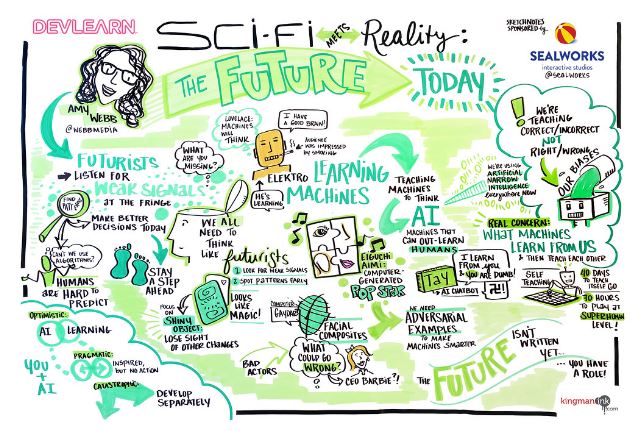The Future of AI for Learning by Lauralee Sheehan
Today’s post comes from Lauralee Sheehan of Learnography, reflecting on her experiences at DevLearn this year.
I don’t know if it’s because I recently saw Bladerunner 2049, but Artificial Intelligence (AI), operating systems, data sets and bots have been on my mind. This was the perfect convergence of inspiration at DevLearn 2017 when the first keynote speaker kicked off the conference with a future-focused discussion on AI. Amy Webb, an acclaimed futurist, spoke about how technology is increasingly intersecting with our everyday lives in weird and wonderful ways and how we can use this approach to change the face of education and the ways in which people learn.
In her Technology Trends 2017 Guide, Amy encourages us to think about AI as the next layer of technology that will be integrated into everything we do. Simply put, AI is a branch of computer science in which computers are programmed to do things that normally require human intelligence. This includes learning, reasoning, problem-solving, understanding language and perceiving a situation or environment.
This, to me, is very exciting! People are consuming and interacting with digital content constantly. For learning, I think that gives us a great opportunity to look at models of digital engagement that are using AI principles to build and shape learning experiences. Take Netflix or Spotify, for instance: both platforms are entrenched in specific user interaction. Artificially intelligent data sets, sophisticated algorithms, collaborative filtering and assumptions help guide and curate which content users will engage with and open up discovery of content that would not necessarily be available otherwise. Back in the day, I remember going into record stores for that exact reason. Namely, I wanted new recommendations of things to explore from experts, underground music that nobody had heard of, and then I became that expert. But now, Spotify can create experience in terms of music engagement and curation with AI. This is what dreams are made of!
And although these examples are from the tech and media space, learning can take a lot of lessons from this model. Potential use cases include: matching customers to the right product/service/experience as they are looking at a website, re-writing content on a site to match the needs of each individual user, conversational interfaces, and security measures such as authenticating someone based on typing habits.
When thinking forward, AI can help us reach a fully immersive era of learning where learning is not about a format or function, but will literally be built into everyday life as a constant and continuous interaction.
Are you interested in sharing your thoughts with our community and the industry at large? Consider contributing a post for the TWIST Blog. If you’re interested, let us know.
This post originally appeared here.


Leave a Reply